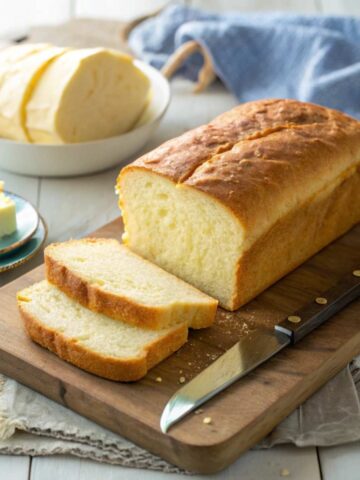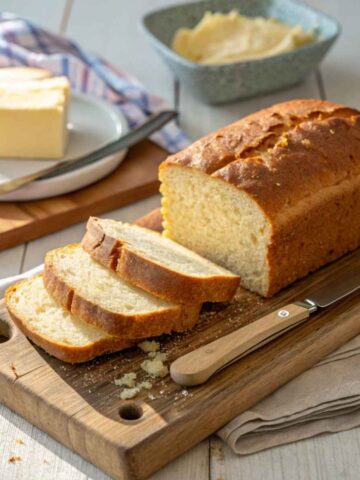Tortillas are a cornerstone of many global cuisines, and their versatility makes them a favorite for meals throughout the day. Whether filled with delicious ingredients for tacos or served with dips as chips, tortillas are incredibly adaptable. However, finding the proper gluten-free tortillas with the perfect combination of flexibility, softness, and flavor can be challenging for those on a gluten-free diet. This guide will help you navigate both store-bought and homemade gluten-free tortilla options.

Jump to:
- What is Gluten?
- Traditional Tortillas vs. Gluten-Free Tortillas
- Types of Gluten-Free Tortillas
- Key Ingredients for Gluten-Free Tortillas
- How to Make GF Tortillas at Home
- How to Choose the Best Gluten-Free Flour for Tortillas
- The Secret to Soft and Flexible GF Tortillas
- Common Challenges
- Best Store-Bought Gluten-Free Tortillas
- Creative Uses for Gluten-Free Tortillas
- Gluten-Free Tortilla Chips: How to Make Your Own
- Storing and Freezing Gluten-Free Tortillas
- Nutritional Benefits
- Conclusion
- FAQs
What is Gluten?
Definition of Gluten
Gluten is a protein found in wheat, barley, and rye that plays a crucial role in helping dough maintain its shape and elasticity. Consequently, it’s the key ingredient that gives traditional tortillas their characteristic chewy texture.
Why Gluten is Problematic for Some People
For individuals with celiac disease or non-celiac gluten sensitivity, consuming gluten can lead to digestive discomfort, inflammation, and other serious health issues. For this reason, finding gluten-free alternatives is essential for maintaining a balanced diet without sacrificing favorite foods like tortillas.
Traditional Tortillas vs. Gluten-Free Tortillas
What Makes Traditional Tortillas Different?
Traditional flour tortillas are made from wheat flour, which naturally contains gluten. As a result, this gluten provides the dough with elasticity and flexibility, making the tortillas soft, pliable, and easy to roll or fold.
The Role of Gluten in Traditional Tortillas
Gluten provides structure and elasticity in flour tortillas. Consequently, without gluten, achieving that same soft, flexible texture can be more challenging. This is why gluten-free tortillas often require additional ingredients, such as binders or moisture-retaining agents, to replicate the desired consistency.
Types of Gluten-Free Tortillas
There are several GF tortillas, each offering different flavors and textures. Here are some popular options:
Corn Tortillas
Corn tortillas are naturally GF and made from masa harina, corn flour. They have a slightly firmer texture and a more pronounced corn flavor than flour tortillas.
Flour Tortillas Made with Gluten-Free Flour
Gluten-free flour tortillas mimic the softness of traditional wheat tortillas. Still, they are made with alternative flour like rice flour, tapioca starch, or sorghum flour.
Cassava, Almond, and Coconut Flour Tortillas
Tortillas made from cassava, almond, or coconut flour are excellent choices for grain-free options. Moreover, each of these flours brings a unique flavor and texture to the tortilla, with cassava flour standing out as the closest to traditional wheat tortillas in terms of flexibility.
Looking for gluten-free options when dining out? Check out our Taco Bell Gluten-Free Guide for safe and tasty meal ideas!
Key Ingredients for Gluten-Free Tortillas
The success of gluten-free tortillas depends on using the right ingredients. Here are some of the most essential components:
Gluten-Free Flours: Rice, Almond, Coconut, and Cassava Flour
- Rice flour: Light and neutral in flavor, rice flour provides a soft base for gluten-free tortillas.
- Almond flour: Adds richness and a slightly nutty flavor, perfect for grain-free options.
- Coconut flour: Absorbent and flavorful, coconut flour creates a more delicate tortilla with a hint of sweetness.
- Cassava flour: Made from the root of the cassava plant, it is one of the best substitutes for wheat flour due to its similar texture and flexibility.
Binders: Xanthan Gum and Psyllium Husk
- Xanthan gum: Helps bind the ingredients together and creates elasticity, mimicking the effect of gluten.
- Psyllium husk: Adds structure and helps hold moisture, preventing the tortillas from becoming too dry or brittle.
How to Make GF Tortillas at Home
Making GF tortillas at home is easier than you might think. Follow this simple recipe for soft, pliable tortillas that are perfect for tacos, wraps, and more.
Want to expand your baking skills? Try our Gluten Free Bread Recipe for a soft, delicious, and easy-to-make gluten-free loaf!
Step-by-Step Guide for Homemade Tortillas
- Gather the ingredients: You’ll need gluten-free flour (such as a blend of rice flour and tapioca starch), water, salt, oil, and a binding agent like xanthan gum.
- Mix the dough: Combine the dry ingredients in a bowl, then slowly add water and oil. Mix until a dough forms.
- Knead and divide: Knead the dough for a few minutes, then divide it into small balls.
- Roll out the tortillas: Roll each dough ball between two sheets of parchment paper to prevent sticking.
- Cook the tortillas: Heat a skillet over medium heat, then cook each tortilla for about 1-2 minutes on each side, until lightly browned.
How to Choose the Best Gluten-Free Flour for Tortillas
The Benefits of Each Gluten-Free Flour
- Rice flour: Provides a neutral flavor and light texture, making it an excellent all-purpose choice.
- Cassava flour is best for mimicking traditional wheat tortillas due to its texture.
- Almond flour adds richness and a slightly nutty flavor, making it great for grain-free tortillas.
How Different Flours Affect the Taste and Texture
Each flour offers unique properties. For instance, cassava flour closely resembles traditional wheat tortillas, coconut flour adds a subtle sweetness, and almond flour delivers a denser texture.
The Secret to Soft and Flexible GF Tortillas
Without gluten, tortillas can sometimes become stiff or brittle. To prevent this, here are some tips to ensure your tortillas stay soft and pliable:
Achieving Pliability Without Gluten
- Use a binding agent: Adding xanthan gum or psyllium husk helps give the dough elasticity and prevents the tortillas from cracking.
- Add moisture: Ensure the dough is adequately hydrated using enough water or oil to keep it soft.
Moisture-Retaining Ingredients for Softer Tortillas
- Oil or fat: Adding a bit of fat to the dough (such as olive or coconut oil) helps maintain moisture and flexibility.
- Milk or dairy-free alternatives: Adding liquid like milk or dairy-free milk can make the dough softer.
Craving pizza? Learn how to make the ultimate Gluten-Free Pizza Crust: Crispy, Chewy, and Irresistible.
Common Challenges
GF tortillas can sometimes be tricky to master. Here are solutions to common problems:
How to Avoid Dry, Brittle Tortillas
- Increase the liquid: If your tortillas turn out dry, add more water or oil to the dough to keep them soft and pliable.
- Use a damp cloth: After cooking, stack the tortillas and cover them with a wet kitchen towel to retain moisture and prevent drying.
Solutions for Sticky Dough
- Flour your surface: If the dough is too sticky to roll out, dust your work surface and rolling pin with extra gluten-free flour.
- Chill the dough: Let it rest in the refrigerator for 10-15 minutes before rolling it out. This helps firm it up and makes it easier to handle.
Best Store-Bought Gluten-Free Tortillas
While homemade tortillas are a fantastic option, several excellent store-bought GF tortillas are available if you’re short on time.
Popular Brands and Their Offerings
- Siete Foods: Known for their grain-free, gluten-free tortillas made from almond flour, cassava flour, and coconut flour.
- Mission Gluten-Free: A famous brand offering gluten-free flour tortillas that closely mimic traditional wheat tortillas' taste and texture.
- La Tortilla Factory: Their GF tortillas, made with rice flour, are soft, flexible, and perfect for wraps.
Reviewing the Top Gluten-Free Tortilla Brands
Each brand has its unique take on GF tortillas:
- Siete’s almond flour tortillas are great for those following a grain-free or Paleo diet.
- Mission’s tortillas are best for those looking for an authentic flour tortilla experience.
- La Tortilla Factory’s tortillas offer a lighter, rice-based alternative with great flexibility.
Creative Uses for Gluten-Free Tortillas
Gluten-free tortillas aren’t just for tacos! Here are a few creative ways to use them in your meals:
Ever wondered if marshmallows are gluten-free? Find out in our article, Are Marshmallows Gluten-Free? Everything You Need to Know.
Breakfast Burritos
Fill GF tortillas with scrambled eggs, cheese, avocado, and bacon for a hearty breakfast burrito that’s easy to take.
Tortilla Chips
For homemade tortilla chips, start by cutting GF tortillas into triangles. Then, brush them with oil and bake them for 10-15 minutes. Additionally, you can add seasoning like chili powder or garlic salt for extra flavor.
Tortilla Wraps for Lunch or Dinner
Use GF tortillas to make wraps filled with your favorite ingredients, such as grilled chicken, veggies, hummus, or deli meats.
Gluten-Free Tortilla Chips: How to Make Your Own
Turning Gluten-Free Tortillas Into Crispy Chips
Making your tortilla chips is easy! Here’s how:
- Preheat the oven to 375°F (190°C).
- Cut tortillas into triangles and place them on a baking sheet.
- Brush with oil and sprinkle with salt or any seasonings of your choice.
- Bake for 10-15 minutes until crisp and golden.
Flavoring Ideas for Homemade Tortilla Chips
- Chili lime: Sprinkle chili powder and lime zest on the chips before baking.
- Cinnamon sugar: For a sweet treat, brush the chips with melted butter and sprinkle with cinnamon sugar before baking.
Storing and Freezing Gluten-Free Tortillas
How to Keep Tortillas Fresh
To ensure your gluten-free tortillas stay fresher for longer, store them in an airtight container at room temperature for up to two days. However, if your tortillas contain dairy or eggs, it is best to refrigerate them.
Freezing Tips for Longer Storage
Gluten-free tortillas freeze well. Stack the tortillas with pieces of parchment paper between them, then wrap them tightly in plastic wrap or place them in a freezer-safe bag. When ready, let them thaw at room temperature or reheat them directly in a skillet.
Nutritional Benefits
The Health Benefits of Using Alternative Flours
Many gluten-free flours, such as almond and coconut flour, are higher in protein, fiber, and healthy fats than traditional wheat flour. This makes GF tortillas a more nutrient-dense option.
Comparing Gluten-Free Tortillas to Traditional Tortillas
While traditional flour tortillas are typically made from refined wheat flour, GF tortillas can be made from whole grains and alternative flours, offering a more wholesome alternative with less refined carbohydrates.
Conclusion
Gluten-free tortillas are an excellent alternative to traditional wheat-based tortillas, offering both variety and flexibility. Whether making them from scratch at home or purchasing store-bought versions, there are plenty of options to suit different tastes and dietary needs. With the right ingredients and techniques, you can create soft, pliable tortillas perfect for all your favorite dishes.
FAQs
Most corn tortillas are naturally gluten-free, as they are made with masa harina, a type of corn flour. However, always check the packaging to ensure no cross-contamination with gluten during processing.
You can substitute xanthan gum for psyllium husk or other binding agents. Both help give the dough structure and flexibility.
Homemade gluten-free tortillas can be stored in an airtight container at room temperature for up to two days. Alternatively, for longer storage, you can refrigerate or freeze them to maintain their freshness.





Leave a Reply